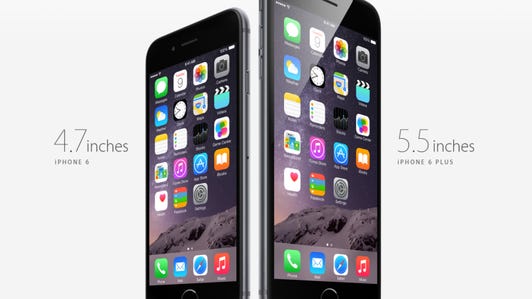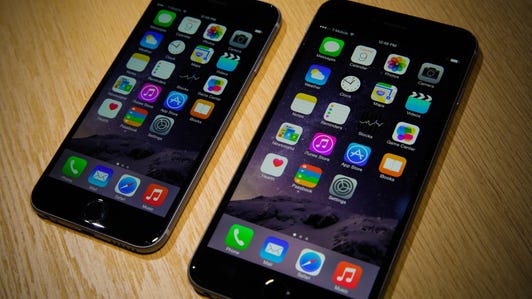

Now playing:
Watch this:
iPhone 6 and 6 Plus
2:03
When Apple’s introduced its two newest marquee handsets yesterday, the most readily discernible difference between the iPhone 6 and iPhone 6 Plus was their sizes. And that’s no wonder — the latter has nearly an inch more display real estate (5.5-inch vs. 4.7-inch) and weighs about 1.5 ounces more than its smaller sibling. The 6 Plus also costs $100 at each storage capacity than its smaller sibling.
But the 6 Plus is much more than just a bigger and pricier iPhone 6. There are a few key spec differences:
Screen: The 6 Plus isn’t just larger — it has a higher resolution (1,920 x 1,080 vs. 1,334 x 750) and a higher pixel density (401 pixels per inch vs. 326 ppi).
Landscape mode: The 6 Plus will be able to use special iPad-style landscape modes on some apps when the phone is held horizontally; the 6 will not.
Camera: Though both devices are equipped with an 8-megapixel lens, only the larger iPhone 6 Plus has optical image stabilization — which should help out any unsteady hand that’s shooting an image or recording a video.
Battery: In addition, the 6 Plus has a higher battery capacity, meaning you can expect to talk, watch movies, and surf the Web for a few hours longer.
For more on the device’s variances, check out our chart below. And for more information, explore CNET’s full Apple coverage from yesterday’s keynote.
The Apple iPhone 6 and iPhone 6 Plus have arrived (pictures)






Apple iPhone 6 vs. iPhone 6 Plus
| iPhone 6 | iPhone 6 Plus | |
|---|---|---|
| Display | 4.7 inches (119.38mm) with 1,334 x 750-pixel resolution | 5.5 inches (139.7mm) with 1,920 x 1,080-pixel resolution |
| Pixel density | 326ppi | 401ppi |
| Dimensions | 5.44 x 2.64 x 0.27 inches (138.1 x 67 x 6.9mm) | 6.22 x 3.06 x 0.28 inches (158.1 x 77.8 x 7.1mm) |
| Weight | 4.55 ounces (129g) | 6.07 ounces (172g) |
| OS | iOS 8 | iOS 8 |
| Camera, video | 8-megapixel; 1080p HD video | 8-megapixel with optical image stabilization; 1080p HD video |
| Front-facing camera | 1.2-megapixel; 720p HD video | 1.2-megapixel; 720p HD video |
| Processor | Proprietary 64-bit A8 chip with M8 motion co-processor | Proprietary 64-bit A8 chip with M8 motion co-processor |
| RAM | N/A | N/A |
| Capacity | 16GB, 64GB, and 128GB | 16GB, 64GB, and 128GB |
| Extra storage | No | No |
| Battery | Nonremovable; talk time up to 14 hours on 3G and Internet usage time up to 10 hours on LTE | Nonremovable; talk time up to 24 hours on 3G and Internet usage time up to 12 hours on LTE |
| Bluetooth | v 4.0 Low Energy | v 4.0 Low Energy |
| NFC | Yes | Yes |
| Waterproof | No | No |
| Colors | Silver, gold, and space gray | Silver, gold, and space gray |
| US retail price | On-contract $199 (16GB), $299 (64GB), and $399 (128GB); off-contract $649 (16GB), $749 (64GB), and $849 (128GB) | On-contract $299 (16GB), $399 (64GB), and $499 (128GB); off-contract $749 (16GB), $849 (64GB), and $949 (128GB) |
| UK retail price | Unlocked £539 (16GB), £619 (64GB), and £699 (128GB) | Unlocked £619 (16GB), £699 (64GB), and £789 (128GB) |
| AU retail price | Unlocked AU$869 (16GB), AU$999 (64GB), and AU$1,129 (128GB) | Unlocked AU$999 (16GB), AU$1,129 (64GB), and AU$1,249 (128GB) |
Update (2:30pm PT): This post has been updated to more clearly delineate the differences between the two models in the introduction.



